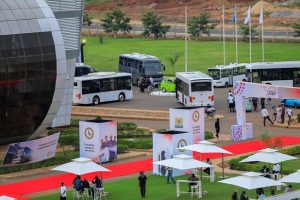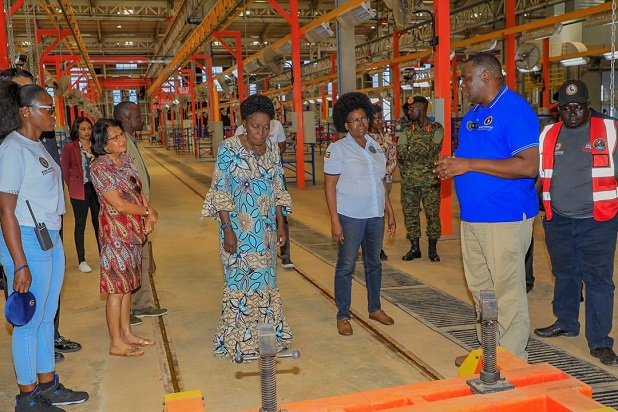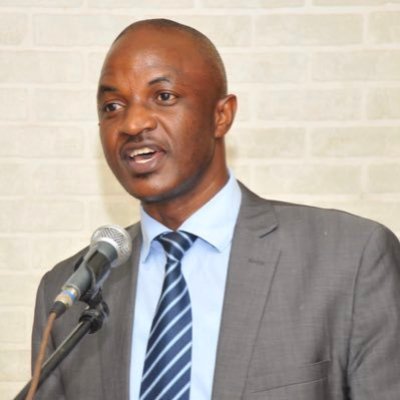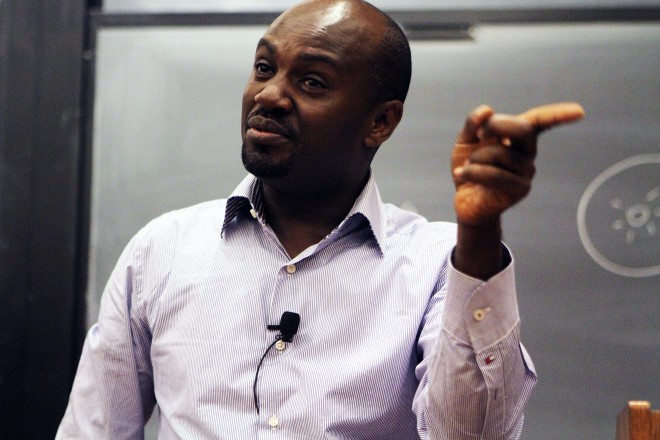Kiira Motors CEO Isaac Paul Musaasizi (in blue t-shirt) briefs Kadaga on the status of Kiira Motors
The 1st Deputy Prime Minister and Minister for the East African Affairs, Rebecca Kadaga, has described as a revolution, the e-mobility journey being championed by Kiira Motors Corporation.
On Friday, Kiira Motors held its first e-mobility expo at the Industrial and Business Park in Jinja. Kadaga was the chief guest. She, like other guests, was taken through a step-by-step process of making electrics buses.
“What is happening here is a revolution,” said Kadaga while addressing participants at the expo.
Kadaga said that the government is committed to a full transition to electric mobility in public transport by 2030 and thus ensuring sustainable development.

Speaking on the sidelines of the expo, the Minister of Science, Technology and Innovation, Dr.Monica Musenero, said the market for electric vehicle is ripe.
She noted that currently, Uganda is focusing on the East and Southern Africa as the market for electric vehicles made in Uganda.
E-Mobility Strategy
Allan Muumuza, the head of e-Mobility at the Ministry of Science, Technology and Innovation, said in the 2022/23 Financial Year, Uganda imported cars worth US$ 795 million. “That is how much vehicles Uganda imported in the Financial Year 2022/2023, up from US$110 million in 1996,” said Muhumuza.
Globally, he added that the mobility industry is valued at about US$ 15 trillion dollars. He adds that this is projected to grow to US$ 26.6 trillion by 2030. “Mobility is the single largest contributing sector to the economy in terms of GDP contribution in the areas of manufacturing, infrastructure among others,” said Muhumuza.
In Africa, Muhumuza says that 10% of “our green house emissions come from mobility.”
“This is expected to grow as the number of Sub Saharan vehicles grow from 25 million in 2021 to over 58 million by 2040. If we don’t do something about this for our future generation, our inheritance will be regrettable. 50% of global travels come from passenger movement, 40% are the movement of goods. E-mobility is expected to grow to US$ 1.5 trillion within the next four years. So, this is the opportunity we are talking about. By 2030, of the 1.2 billion cars on the road, 200 million of these will be electric. Africa is an emerging market for e-mobility with an emerging rate of only 44 vehicles per 1000 people. There is still grate potential for Africa,” said Muhumuza.
In Uganda today, Muhumuza says there are 140, 000 privately owned electric vehicles and motorcycles. Of these, 55, 000 are passenger vehicles. Unfortunately, he says that 80% of these are used at an average of 16 years.
Around 2023, Muhumuza says petroleum which is used to drive these cars, accounted for 27% of Uganda’s import bill. “This is hemorrhaging of the foreign reserves. So, we need to switch to have the money coming in and the vehicles are the ones going out? The problem we are trying to solve is multifaceted. The cost to the economy. 8% of our import bill on just vehicles. Poor energy efficiency. We are losing Shs 500 million daily from burning diesel and petrol in traffic jam. Uganda is among the most polluted cities in the world. If we don’t do something about our emissions, economic cost to climate change could equal up to 3% of our GDP on a business as usual scenario,” he said.
The National e-Mobility Strategy, therefore, he said, targets to position Uganda as a net source rather than a consumer of e mobility tools and solutions in Africa, and to reduce “our dependence on imports and improve the well being of Ugandans” with a vision to fully transition public transport by 2030 and passenger vehicle sales by 2040 and to build a self sustaining e-mobility eco system in Uganda.
Under this strategy, local EV manufacturing is top priority. Others ate local EV battery production, electrifying public transport, establishment of charging network, human capital development and e mobility standards development.
The intention is to make 500, 000 electric cars per year by 2030.
“So, far, we have a capacity of 10, 000 electric buses and motorcycles. The target to have 65% of local content by 2030. Mobilize at least 500 billion dollars in the medium term to make sure we can do Research and Development, Development and Market Systems. So far, we have seen an investment of 140 million dollars from the government and the private sector,” said Muhumuza.
The Strategy also targets to have at least 15, 000 buses deployed on Ugandan roads by 2040.
Currently, Uganda has 27 Kayoola electric buses on the road and over 3, 000 locally produced boda bodas.
The plan is also to have 10, 000 fast chargers within a 50 kilo meter radius with 3, 000 public charging stations. Uganda currently has 30 DC fast chargers in the country with four public charging stations in Kampala and over 140 swapping stations across the country.
Muhumuza says that the other target is to have 250, 000 people skilled along the entire value chain.
With all these interventions, Muhumuza says that the sector expects to contribute 12.5% to the national GDP.
“We expect to have fully transitioned (to e-mobility) by 2040,” says Muhumuza.





